Essential Guideline to Thailand: Food Culture and Eating Style
Thailand’s food culture is considered a heritage that has been passed down through generations, reflecting a way of life, wisdom, art, and culture through beautifully presented and aromatic dishes. It is a source of pride for all Thai people for a very long time. Let’s explore the essential elements of Thai food culture that you should know before visiting Thailand.
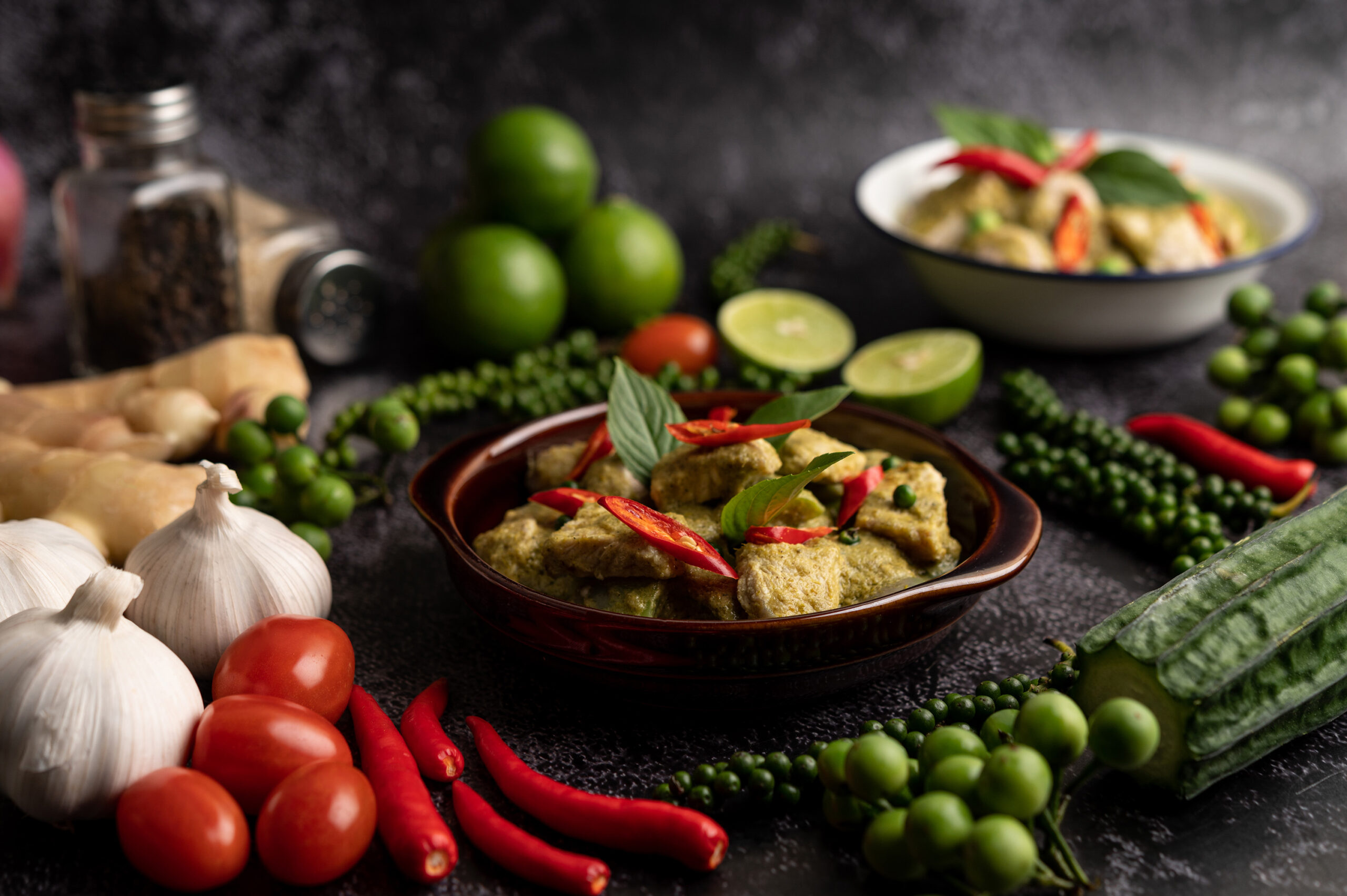
Get To Know Thai Food
Thai food is the staple cuisine of Thailand, with a rich tradition and culture continuous heritage that has been passed down from the past. It has become a national identity and is deeply ingrained in Thai culture.
Thai food culture stands out from other cuisines due to its unique blend of flavors, carefully selected ingredients, and intricate cooking techniques. It is characterized by the harmonious combination of various ingredients, as well as the meticulous presentation. Thai food is also known for its distinctive and balanced flavors, encompassing the five fundamental tastes: sour, sweet, salty, bitter, and spicy. It depends on the preferences and desires of the diners.
One typical Thai meal, there is a delightful blend of various types of dishes served together. These may include curries, soups, stir-fried dishes, chili pastes, dipping sauces, fresh vegetables, and various types of salads. The flavors of these dishes often balance the spiciness and richness, allowing diners to choose according to their preferences. Examples of diverse and prominent Thai dishes include Green Curry Chicken, Tom Yum Goong (spicy shrimp soup), Massaman Curry, Pad Krapow (stir-fried basil), Pad Thai, Som Tum (green papaya salad), and many more.
Characteristics of Thai Food Culture
Thailand has had a longstanding reputation for its cuisine. Thai people think that food is more than just sustenance—it is a vital aspect of life. Sharing meals, whether it’s lunch or dinner, is a significant way of fostering and strengthening relationships among individuals. Thai food culture is renowned for its uniqueness, which has been passed down through generations and continues to be cherished to this day. These are various characteristics that illustrate the uniqueness of Thailand’s food culture:
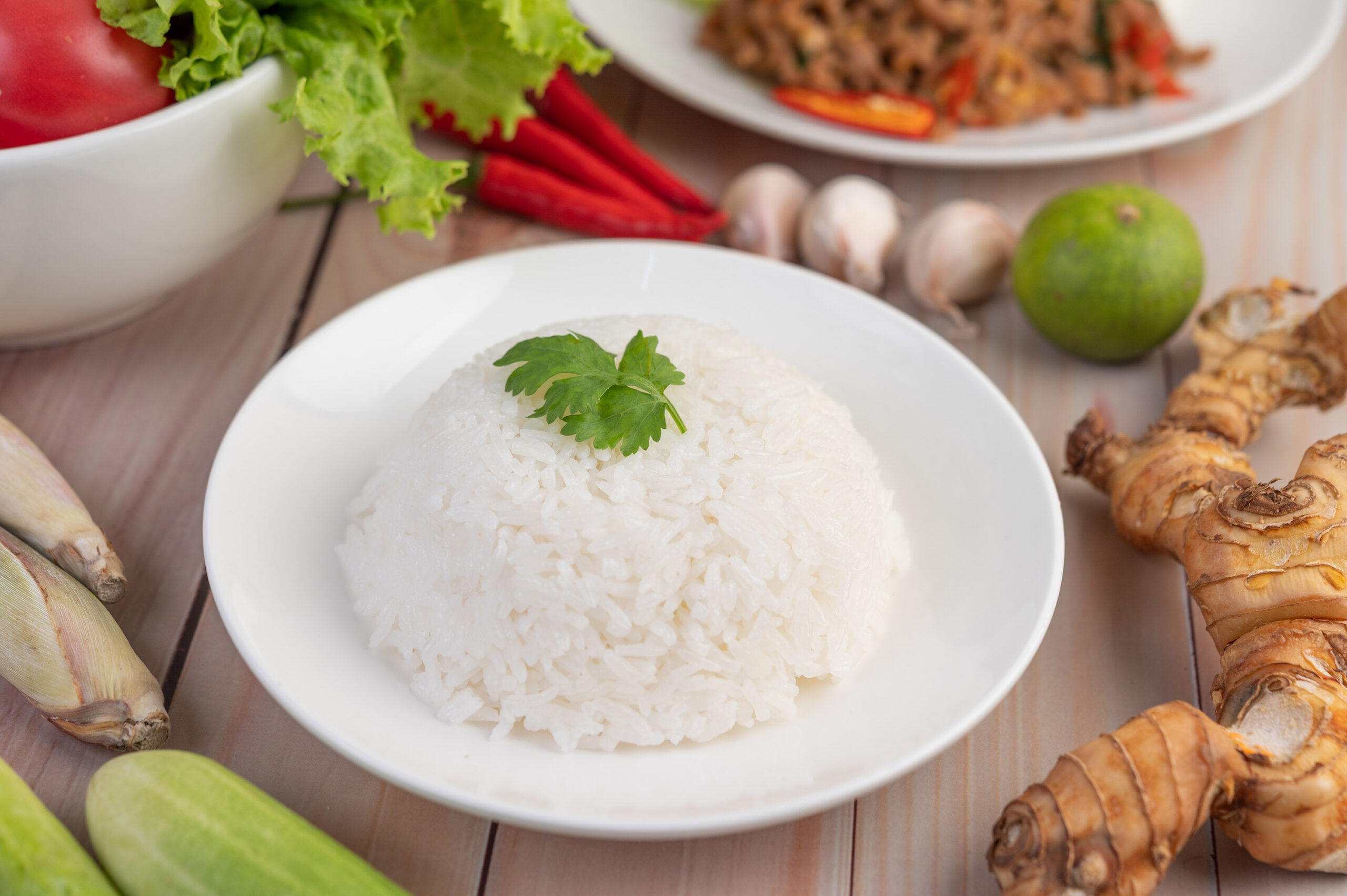
Rice is a staple in Thai Food Culture
The main staple of Thai people since ancient times is “rice,” whether it’s steamed rice or sticky rice. We commonly consume rice in every meal, and “side dish” is a fundamental aspect of Thailand’s food culture. “Side dish” refers to the combination of dishes and condiments eaten with rice, and it can be categorized into 6 types: curries, salads and dips, chili pastes or dipping sauces, stir-fries, and side dishes. This tradition of accompanying rice with various dishes has been a distinctive aspect of Thai eating since ancient times and continues to be practiced today.
Thai food is is meticulous at every step
Thai food is a culture that emphasizes attention to detail at every step. Whether it’s savory dishes or desserts, there are intricate processes involved in ingredient selection, flavor preparation, and presentation. For example, in Green Curry, one must meticulously pound green chilies with other ingredients before stir-frying them with fresh coconut milk. Achieving the perfect curry requires time and precision in each step.
Similarly, Thai desserts like “Look Choop” (Fruit Shaped Mung Bean) involve intricate molding and coloring of mung beans to resemble various fruits. After molding, they are dipped in gelatin to create a glossy appearance and then smoked to enhance the aroma. All of these examples illustrate the meticulous and thoughtful approach at every stage of Thai culinary arts.
Thai food emphasizes refinement
Thai cuisine isn’t just about great taste; it also values aesthetics, making it a feast for the eyes. The art of vegetable and fruit carving is one of Thailand’s food cultures, known for its intricate and meticulous nature. Delicate patterns are carved into the vegetables and fruits using a knife, resulting in beautiful decorations that embellish serving dishes. Besides their aesthetic appeal, these carved vegetables and fruits are also edible and can be enjoyed as part of the meal.
Thai Foods encompasses seven flavors
The uniqueness of Thailand’s food culture that sets it apart from other cultures is the presence of all seven flavors in a single dish. For example, the dish “Miang Kham” (savory leaf wraps) incorporates the sourness from lime, sweetness from palm sugar, saltiness from shrimp paste, bitterness and spiciness from ginger, richness from roasted coconut, and astringency from lime leaves and lime peel. This showcases the harmonious blend of flavors from various ingredients, highlighting the distinctiveness of Thai taste.
Thai Food is medicine
One of Thailand’s food cultures is rich in various herbs and vegetables, many of which possess medicinal properties derived from phytochemicals. These ingredients contribute to maintaining good health and improving overall well-being. For instance, dishes like “Gaeng Liang” (a vegetable soup) and traditional ancient curries aid in digestion.
In the hot season, characterized by intense heat, people often consume cooling vegetables like zucchini, cucumber, and watermelon to combat the heat. Spicy and warming vegetables such as young ginger and turmeric are favored during the rainy season when digestive issues are prevalent. In the cold and dry winter season, fibrous and hearty vegetables like pumpkin and various greens are chosen to aid in digestion and add bulk to the diet.
The choice of vegetables is adapted to the seasonal context, aligning with traditional Thai wisdom on maintaining balance and well-being.
Thai food culture utilizes natural packaging
Thailand’s food culture is using natural materials such as bamboo cylinders, banana leaves, coconut husks, and pandan leaves to wrap and package food, combined with traditional techniques of folding, tying, and arranging, has become a distinctive feature of Thai cuisine.
For example, dishes like “Khao Tom Mat” (sticky rice parcels) are wrapped using pandan leaves and tied with bamboo strings before being steamed until cooked. Not only do these natural materials contribute to the unique presentation of Thai food, but they also infuse a delightful aroma into the food.
Thai Food Culture with four regions
Thai food from the four regions has its own distinctive characteristics and flavors based on culture and traditional practices. Let’s explore the unique dishes from each region of Thai cuisine
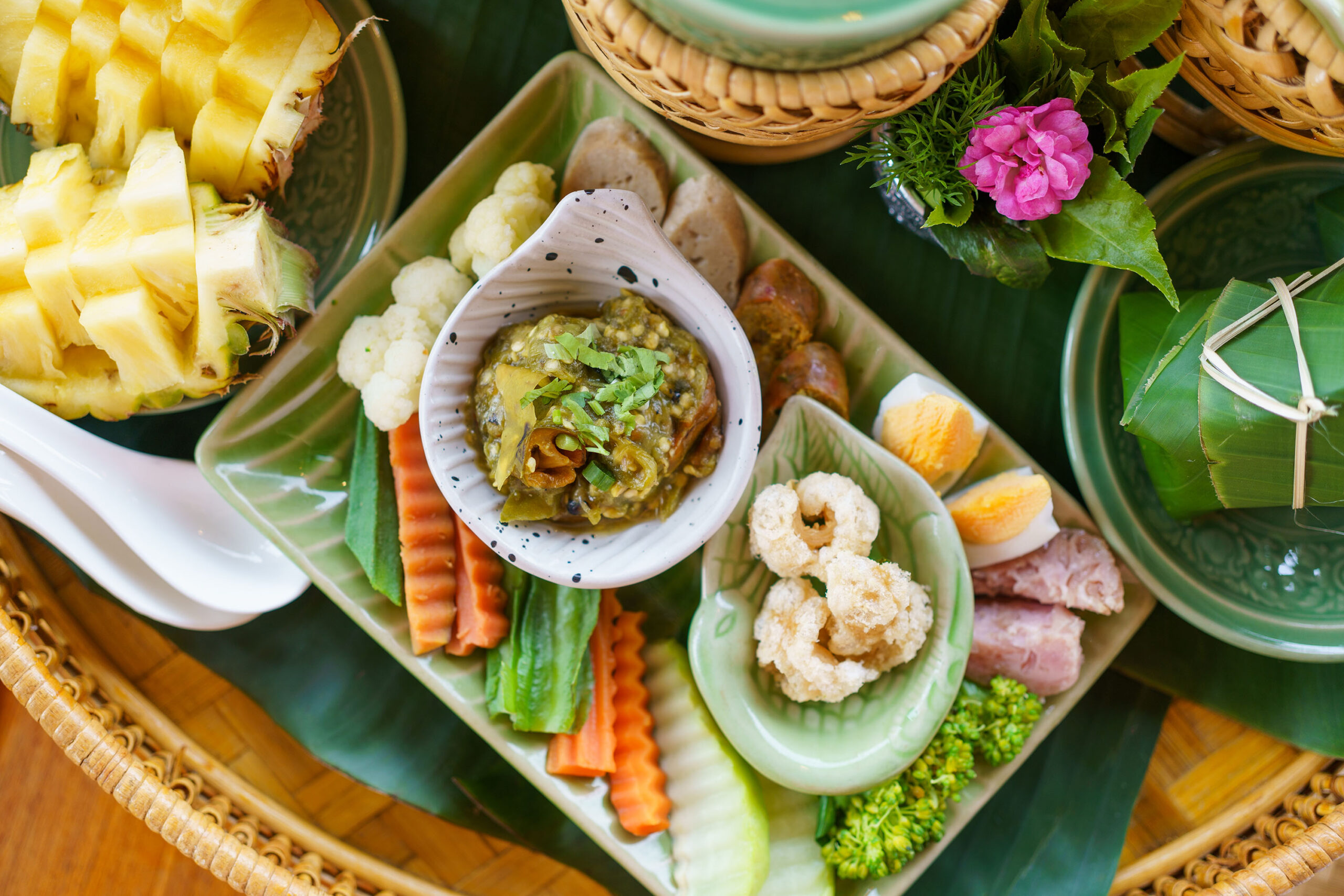
Northern Thai Food
The Northern region of Thailand is characterized by a landscape of alternating mountain ranges and valleys, extending from the north to the south. The region experiences cool temperatures due to its mountainous terrain. The unique climate and geography contribute to a diverse range of flora, distinct from other regions. Examples of plants found in this region include eggplants, sesame flowers, young green chilies, white turmeric, and kaffir lime.
Parts of this region share borders with Myanmar, It is home to various Thai hill tribes, resulting in a diversity of cultural practices and traditions. influencing a blend of cultures and traditions. The local people here are gentle and tender, living a simple and peaceful lifestyle typical of the Lanna urban culture.
In Northern Thailand’s food culture, sugar is not commonly used for sweetness. Sweetness is achieved through natural ingredients used in the cooking process, such as certain vegetables and fish. Fats come from animal fats, and popular meats used include pork, chicken, beef, and freshwater fish. There is a variety of preserved foods widely used today, including fermented pork, pork rind, sour pork sausage, fermented soybeans, and nam prik pla ra (fermented fish paste).
Example of Northern Thai Food such as: Nam Prik Nhum (Young chili dip), Nam Prik Ong (Tomato and minced pork dip), Kaep Mu (Crispy pork rinds), Sai Ua (Spicy sausage), Gaeng Ho (Spicy meat curry), Gaeng Hang Lay (Pork belly and pork curry), Khao Soi (Curried noodle soup), Khao Soi Noodles.
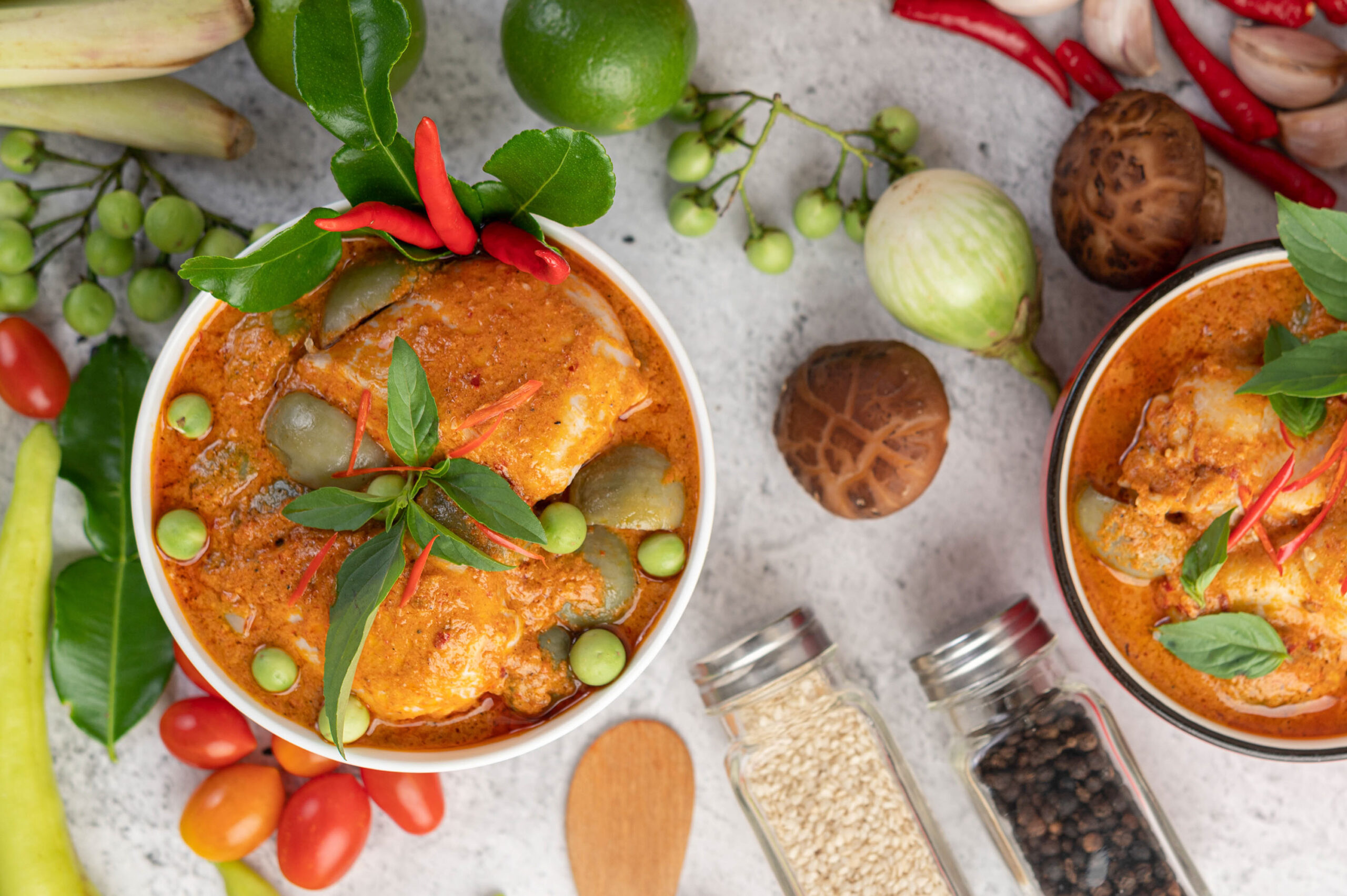
Central Thai Food
Central is characterized by its diverse geography, consisting of plains and some low mountains. Major rivers like the Chao Phraya, Tha Chin, and Mae Klong run through the region, providing fertile lands suitable for agriculture and livestock. This abundance makes it the most agriculturally productive region, historically serving as the location of the capital for centuries, from the Ayutthaya period to the Rattanakosin era.
This central location facilitated cultural exchange and influence from foreign cuisines, including stir-frying techniques and the use of woks and oils from Chinese cuisine, golden desserts and sweets like Thong Yip (Pinched gold egg yolks) influenced by the Portuguese, and curry spices introduced by Indian immigrants.
The Thai food culture of this region is known for its diversity in flavors, influenced by various cultural and historical factors. Rice is a staple and often the central component of the meal. Tables are usually adorned with a variety of vegetable garnishes and beautifully crafted dipping sauces. Central Thai food is known for having a wide variety of desserts and snacks compared to other regions.
Example of Central Thai Food such as: Nam Prik Long Ruea (ฉhili dip served on a boat), Nam Prik Kapi (Shrimp paste chili dip), Hor Mok (Curry custard), Tod Mun (Fish cakes), Pu Ja (Crab meat), Gang Jued (Clear soup), Gang Phed (Spicy curry), Gang Som (Sour curry), Fried Rice, Various types of salads.
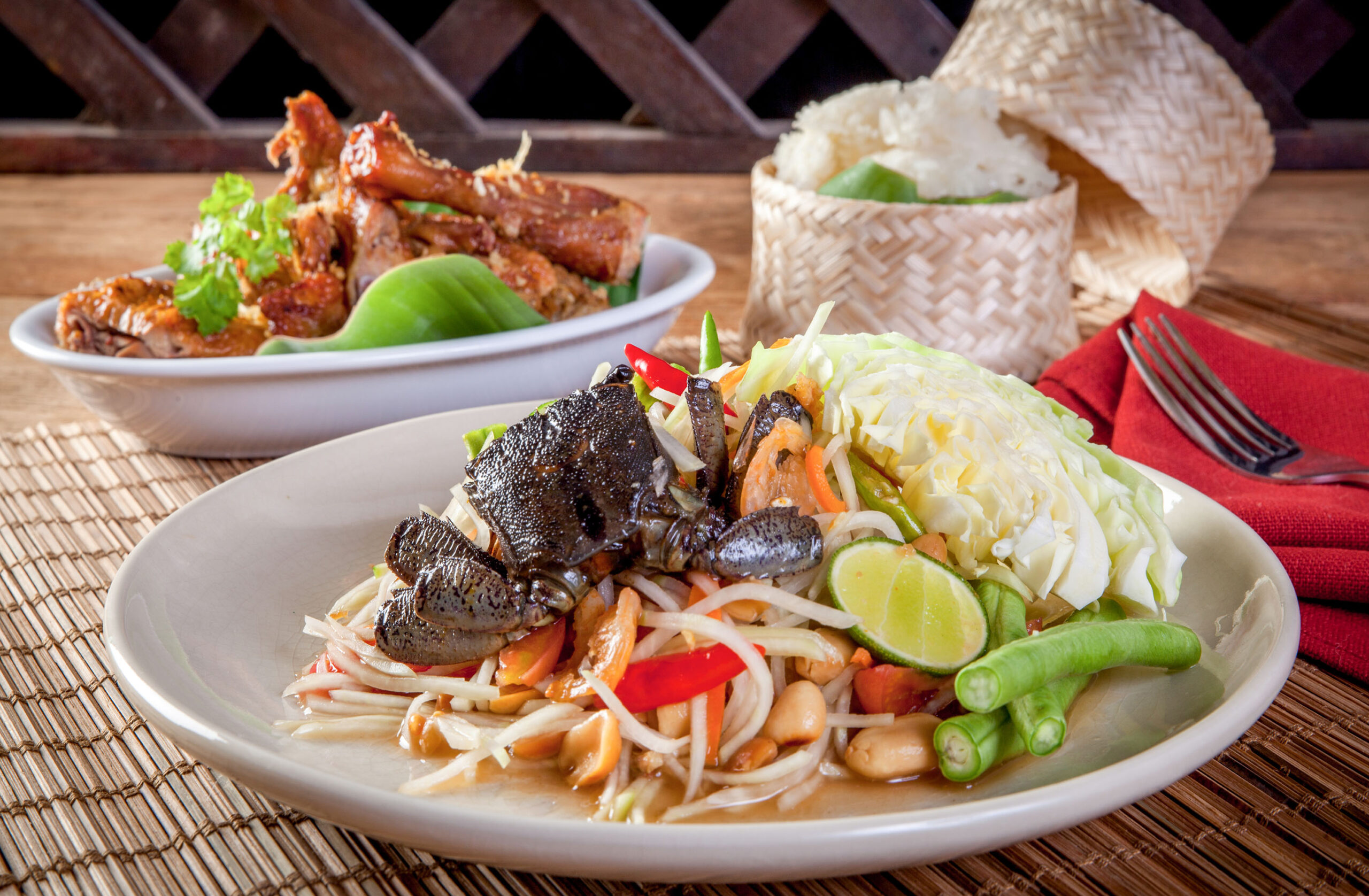
Northeastern Thai Food (Isan)
Isan, predominantly a plateau region, is characterized by highlands, small hills, and extensive plains. The area is suitable for livestock farming and features broad fields. Sticky rice is a staple in the diet, and the cuisine is known for its salty, spicy, and sour flavors.
Food preparation in Isan doesn’t emphasize the color or presentation of the dish much. The aroma comes from spices similar to other regions, but Thailand’s northeastern food culture often includes herbs like “bai maenglak” (Hairy basil), “pak chee lao” (Dill), and “pak chee farang” (Stinkweed) in almost every dish. Curries in Isan cuisine typically do not include coconut milk. Local people in this region enjoy simple and uncomplicated meal preparations.
Example of Northeastern Thai Food (Isan) such as: Bamboo Shoot Soup, Sour Soup, Spicy Meat Soup, Fermented Fish Spine Soup, Mushroom Curry, Red Ant Egg Curry, Spicy Peanut Salad, and Som Tum (Green Papaya Salad).
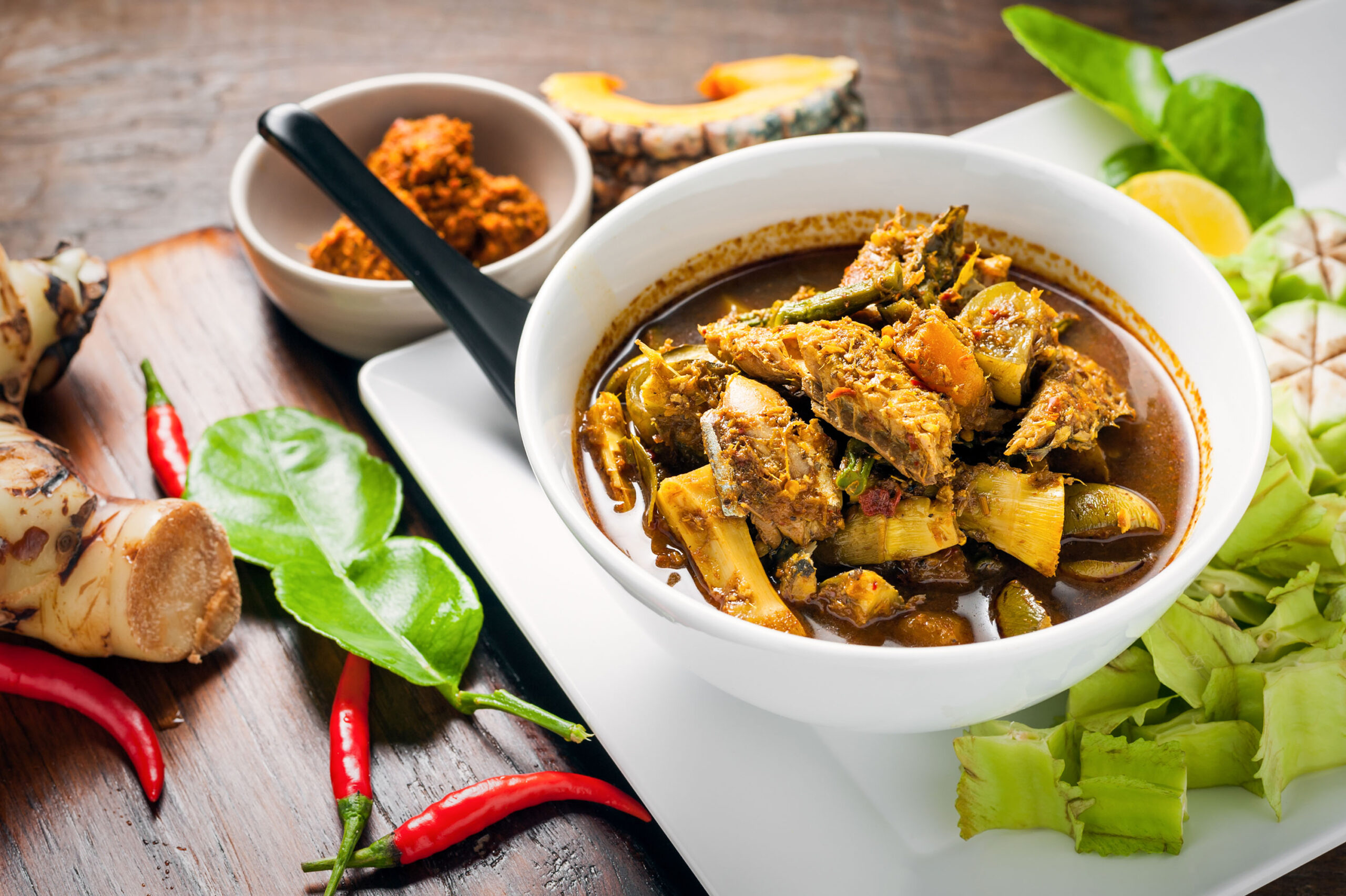
Southern Thai Food
Southern Thailand is characterized by a peninsula that extends into the sea, bordered by the Gulf of Thailand on two sides. The Tanaosri Mountain Range is located to the west, serving as a natural boundary between Thailand and Myanmar.
The region experiences heavy rainfall, and the rainy season lasts longer compared to other parts of the country. Consequently, the vegetables used in Southern Thai cuisine vary from those in other regions and include ingredients such as sato, ngio, mango (specifically the “himpaporn” variety), bamboo shoots, and cha-om leaves.
Thailand’s Southern food culture is generally known for its bold flavors, typically characterized by spiciness, saltiness, and sweetness derived from coconut milk. Saltiness comes from ingredients like shrimp paste (kapi), fish sauce (nam pla), and budu. Sourness is obtained from lime, kaffir lime, mini mango (Mamuang baw), and garcinia. Additionally, the yellow color of Southern Thai dishes often comes from turmeric, adding both color and fragrance. Seafood is a staple in Southern Thai cuisine, and vegetables are often included to balance the spiciness.
Example of Southern Thai food such as: Gaeng Tai Pla (Spicy and pungent fish kidney curry). Gaeng Som (southern sour soup) Gaeng Leung Yellow curry) Gai Tom Kamin (Turmeric soup with chicken) Gai Koa Lae (Marinated grilled chicken) Pla Krabok Tom Som (Mackerel fish soup flavored with sour) Khua Kling (Southern Stir-Fried Pork with Yellow Curry Paste) Pad Sator (Stir-fried stink beans with meat or shrimp) Phad Phet Gob (Stir-fried spicy frog) Yum Nam Bu Du (Spicy rice salad with vegetable)
Thailand Eating Culture
In present-day Thailand eating culture typically involves the use of large spoons and forks, a contrast to some other countries. For Thais, this is considered appropriate. They hold the spoon in their right hand and use it as a substitute for a knife to cut smaller food pieces. It’s common to tear food into smaller pieces rather than cutting them with a knife.
When it comes to the general dining style, Thais often try a variety of dishes during a meal, enjoying one dish at a time and usually accompanied by rice. The larger bowl is commonly used for soup or certain curry dishes, and it’s common to have a variety of dishes on the table, encouraging a communal style of eating. The meal is typically served with a selection of condiments and sauces to add flavors and spice to the dishes.
When eating, Thais do not combine various foods on their plates, but rather, they sample one dish at a time, but take a small amount and keep going back for more. Always eaten with a mound of rice on an individual plate. Bowls are used mainly for soup, not in place of an eating plate.
Importance of Food in Thai Culture
Thailand’s food culture is not just about satisfying hunger and enjoying flavors. It’s about appreciating the art and the soul of the food, bringing joy and satisfaction through the senses and the taste of the food. Thai cuisine is meticulously crafted, presenting its beauty and convenience in a few carefully chosen words. The flavors are harmoniously blended, enticing diners and leaving them satisfied.
Thai food not only satiates the palate but also brings families together, reflecting the intention and care of the cook. This fosters a sense of warmth and well-being, promoting good mental health for both the creator and the consumer.
In addition to benefiting families, Thai cuisine embodies the Thai identity and the artistry ingrained in our heritage. It is reflected in the meticulous preparation, decoration, seasoning, and consumption of food with an artistic and distinctive touch. From harmoniously blending scents and flavors to crafting a rounded, delightful, and prominently flavored dish, Thai cuisine showcases a unique expertise.
Thai flavors stem from authenticity, adapting and combining distinctive components of each dish, ensuring a perfect blend or contrast that creates a uniquely delicious taste. The consumption of Thai food often includes various fiber-rich dipping vegetables, loaded with vitamins and minerals, contributing to a healthier well-being for the diner.
Thai food culture stands out as it carries forward and adapts to the times while retaining its national identity. It reflects the significant culture of Thailand, showcasing a blend of tradition and modernity. This culinary tradition has become a distinctive national emblem, symbolizing the essential culture of Thailand.
Summary
Thailand’s food is a culture characterized by distinctiveness in its choice of ingredients and meticulous cooking processes. Attention to detail is paramount at every stage to ensure a beautiful presentation and delightful taste. It encompasses a wide array of nutritional values. Thai food serves as a focal point in family relationships because Thais enjoy communal dining, each person having their own plate of rice and sharing different dishes. Spoons and forks are the primary utensils used for dining.
Thai food culture is further divided into four regions, each showcasing unique regional dishes that reflect the local traditions. If one desires to taste the authentic flavors of a particular region, they must travel there. For instance, those interested in Northeastern cuisine must journey to the Isaan region. Following this gastronomic adventure, exploring the beauty of the region becomes an opportunity. Travelers can find serene and picturesque accommodations close to nature, like Rancho Charnvee Resort, which warmly welcomes tourists and those seeking a tranquil and impressive retreat.

